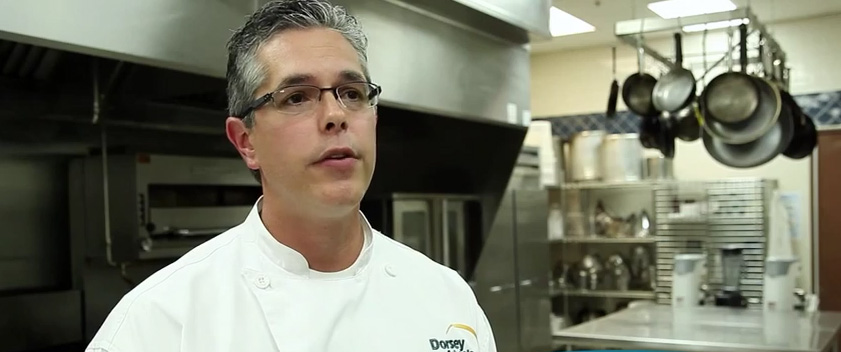Thanksgiving is right around the corner, but it’s definitely not too early to begin thinking about the menu for this big day. If the thought of crafting your Thanksgiving meal menu intimidates you, never fear, Dorsey Culinary Academy can help. Throughout the month of November, we’ll have a series of articles containing tips on how you can create a memorable meal for your Thanksgiving feast. We’ll cover the turkey, sides, desserts, even leftovers!! So stay tuned throughout the month for helpful tips from Dorsey Culinary Academy on how you can craft a delicious Thanksgiving feast.
How to Cook a Thanksgiving Turkey
Not surprising, when most people think about Thanksgiving, they automatically think about turkey, right?! So, it just made sense for us to start with this showpiece of the Thanksgiving meal. We recently sat down with Chef John Piazza CEC, Program Director for Dorsey Culinary Academy, to talk turkey…about the turkey that is!
What’s the best way to thaw your turkey? How much time should you allow for your turkey to thaw completely?
“The best way is to thaw your turkey is in the refrigerator. A turkey is too large to thaw under cool running water and you will get a dry and uneatable bird when cooked from frozen. The general rule is to allow one day of thaw for every 5 pounds of turkey. Because there are so many variables, I always add one extra day.”
How will I know when my turkey is done? I don’t want it to be dry, but I want to ensure it is safe to eat. What’s the best way to check the temp of your turkey during cooking? Do those “pop-up” thermometers really work?
“The Turkey is done when a thermometer is injected into the thickest parts of the bird (breast and inner thigh) and it reads 165 degrees F. The bird is not done until that point no matter how you are cooking your bird. One step that is missed often is the after cooking resting time for the turkey. It is hard work to be roasted in the oven so give your turkey at least 20 minutes out of the oven before slicing. The extra time to rest allows the juices in the turkey to redistribute evenly throughout the turkey moistening the meat. The “pop-up” timers only work sometimes, so I do not rely on them. The thermometer is the best way to ensure you are serving a safe and fully cooked turkey.
Is it safe to cook my stuffing inside the turkey?
“It is safe if two things happen. The first is that you must increase the total cooking time of your turkey at least 20 minutes with an average 20 pound turkey. The second is that a calibrated thermometer must read 165 degrees F in both the thick part of the turkey AND in the center of the stuffing. The entire bird and stuffing must reach this temperature for safety.”
How often should I baste my turkey?
“From the start to the last hour of cooking, your turkey should remain covered. When the turkey is covered, basting is not required. Once you are in the home stretch and there is only an hour left, uncover the turkey and begin the basting process. Continue to baste the turkey every 10 minutes with a baster. As the last hour comes to an end, you should see a golden brown skin developing.”
What’s the most common mistake people make when cooking their turkey? “The most common mistake in cooking turkey is to not allow enough time to cook your bird. Unstuffed turkeys cook in a 325 degree F oven approximately 20 minutes per pound. A 16-20 pound turkey (fully thawed) will need 4 to 5 hours.
We all know that smaller pieces of meat cook faster than big ones. One tip to help your entire turkey cook evenly and end up juicy is to keep the small pieces like the wings and legs close to the body of the turkey. Most turkeys come with a leg tie that gets discarded when removing the giblets from the cavity of the bird. Reattach the leg tie and make sure the legs are close to the body. The next step is to fold the wing tip under the wing joint and tuck it next to the body.”
What’s your preferred method of cooking your Thanksgiving turkey? “I prefer to roast my turkey in the oven after a short two hour soak in a seasoned brine.”
The Culinary Arts Training Program at Dorsey Schools
If you love cooking for family and friends, you may want to consider training for a career in the culinary arts. The Culinary Arts program at Dorsey Schools is designed to take a student’s passion for simple ingredients and transform them into delicious dishes. The hands-on training program at Dorsey Schools is designed to expose students to a variety of topics in the culinary industry such as mise en place, butchering, menu planning, kitchen management, baking & pastry, and more! Instruction takes place in both the classroom setting as well as the kitchens on campus providing students with a balanced approach to learning.
The Culinary Arts program is offered at the following Dorsey Schools campus locations:
Want to learn more? Give Dorsey Schools a call at 888-422-1188 or click here to request information.
Culinary Arts Program – Gainful Employment Disclosures
For more information about our graduation rates, the median debt of students who have completed the program, and other important information, please click here.


